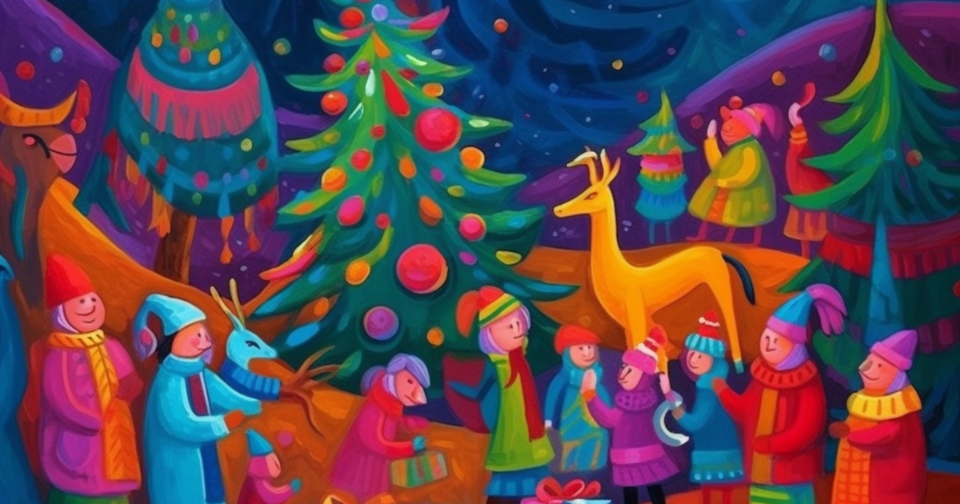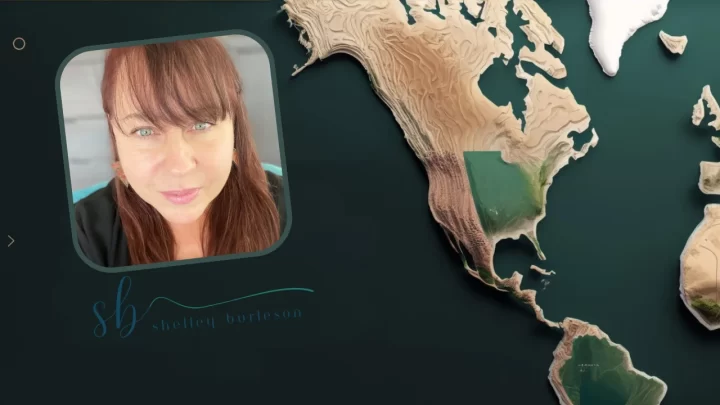This post may contain Amazon affiliate links which means, as an Amazon Associate, I may receive a small commission from purchases made through these links at no cost to you. I only recommend products I have personally used. To learn more, please see my privacy policy page.
Christmas is a holiday celebrated by millions of people around the world, traditionally observed on December 25th. It has both religious and cultural significance, and its observance includes a variety of customs and traditions.
Key Words
- Aurora Borealis
- Bethlehem
- Christmas Island
- Christmas Markets
- Julbord
- Krampus
- Nativity Scenes
- Sinterklaas
- Winter Solstice
- Yule Lads
From icy northern lights to sunny southern beaches, every corner of the world adds its unique sparkle to the season. Dive deeper into this festive exploration as we travel from continent to continent, uncovering the unique ways in which geography influences Christmas traditions. Witness the transformation of landscapes into winter wonderlands or sunny festive retreats, each with their own story to tell. From ancient rituals to modern celebrations, join us in discovering the vibrant and diverse ways that communities around the world come together to celebrate the spirit of Christmas. Read on…
Key Takeaways
Religious Significance: For Christians, Christmas is a sacred religious holiday that commemorates the birth of Jesus Christ, whom Christians believe to be the son of God and the savior of humanity as described in the New Testament of the Bible. The celebration of Christmas is marked by religious services, including Midnight Mass on Christmas Eve and various church services on Christmas Day.
Cultural Significance: Beyond its religious roots, Christmas has become a widely celebrated cultural holiday, observed even by non-Christians in many parts of the world. The cultural celebration of Christmas includes various traditions such as decorating Christmas trees, exchanging gifts, sharing festive meals with family and friends, and the figure of Santa Claus, also known as Father Christmas, who is believed to bring gifts to children.
Global Celebrations: The ways in which Christmas is celebrated vary greatly around the world, influenced by local customs, culture, and geography. Some countries have unique traditions, foods, and decorations associated with Christmas. The holiday season is often characterized by a spirit of goodwill, generosity, and community.
Historical Origins: The exact origins of Christmas and the choice of December 25th for its celebration are complex and draw from various historical, religious, and pagan traditions, including the Roman festival of Saturnalia and the winter solstice.
Introducing Christmas Around the World
As the calendar turns to December, twinkling lights and festive decorations begin to adorn streets and homes around the world, heralding the arrival of Christmas. This beloved holiday, rich in history and steeped in myriad traditions, transcends borders, and unites people across the globe in a celebration of faith, family, and festivity. Yet, beneath the universal imagery of Christmas, lies a mosaic of unique customs and practices, each shaped by the geography of its region.
The influence of geography on Christmas traditions is both profound and multifaceted. From the snow-capped mountains of Scandinavia to the sun-drenched beaches of Australia, the physical landscape plays a pivotal role in defining how communities experience and celebrate this festive season. In colder climates, Christmas is often synonymous with a winter wonderland, complete with sleigh rides and cozy fireside gatherings. Meanwhile, in the Southern Hemisphere, the holiday coincides with the height of summer, leading to celebrations that are imbued with warmth and sunshine.
Beyond mere climate, the geographical location of a region also influences the cultural aspects of Christmas. Historical trade routes, colonial legacies, and local religious practices intertwine to create distinct regional flavors of the holiday. For instance, the Christmas markets of Europe, with their origins in medieval winter festivals, offer a glimpse into the continent’s rich cultural tapestry. In contrast, the Caribbean islands infuse their celebrations with vibrant local music and customs, reflecting their diverse cultural heritage.
As we embark on this global tour of Christmas traditions, we are reminded of the powerful ways in which geography shapes our cultural practices and identities. The festive season, with its myriad expressions around the world, provides a fascinating perspective through which to explore the diversity of human geography. Through this exploration, we not only celebrate the unique traditions of Christmas but also gain a deeper appreciation for the rich and varied cultures of our world.
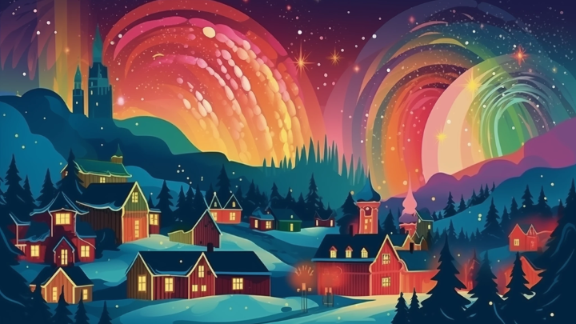
The Northern Lights of Christmas: Scandinavia
In the enchanting lands of Scandinavia, where the aurora borealis dances across winter skies, Christmas is a time steeped in ancient traditions and folklore, deeply intertwined with the region’s stark and beautiful geography. The rugged landscapes, long nights, and snow-laden forests of Nordic countries have given rise to some of the most unique and captivating Christmas customs in the world, blending pagan rituals with Christian beliefs.
The Magic of the Yule Lads in Iceland
In Iceland, the tradition of the Yule Lads, or ‘Jólasveinarnir’, adds a whimsical touch to the festive season. Originating from Icelandic folklore, these thirteen mischievous characters visit children across the country in the thirteen nights leading up to Christmas. Each Yule Lad has a distinct personality, ranging from Spoon-Licker, who stealthily licks spoons, to Window-Peeper, who looks through windows in search of things to steal. These playful figures reflect Iceland’s rich storytelling tradition, influenced by its isolated and dramatic landscapes.
The Influence of Geography on Celebrations
The geography of Scandinavia, characterized by its northern latitude, plays a significant role in shaping its Christmas customs. In countries like Norway, Sweden, and Finland, the winter solstice brings some of the shortest days of the year, with towns and villages plunged into long hours of darkness. This has led to a Christmas celebration that is deeply connected to light and warmth. Homes are adorned with candles and fireplaces are kept burning, creating a cozy atmosphere that contrasts with the harsh outdoor environment.
Outdoor Festivities and Nature's Influence
Outdoor activities are a key part of the Scandinavian Christmas experience. In Norway, families often gather in the forest to cut down their Christmas tree, a ritual that reflects the deep connection to the vast Nordic woodlands. In Sweden, the Saint Lucia Day procession on December 13th, where girls and boys dressed in white gowns and holding candles sing traditional songs, is a testament to the enduring influence of light in the darkest time of the year.
Culinary Traditions Rooted in Geography
The regional cuisine during Christmas also speaks to the geographical conditions of Scandinavia. Dishes like the Swedish ‘Julbord’, a lavish smorgasbord featuring a variety of fish, meats, and breads, showcase the abundance of local produce and the historical reliance on preserved foods during the long winters. Similarly, in Finland, the Christmas table is laden with an array of dishes that emphasize local ingredients like reindeer, root vegetables, and fish.
The Christmas traditions of Scandinavia are a delightful combination of geography, climate, and cultural heritage. From the mystical Yule Lads of Iceland to the warm glow of candles in Swedish homes, these customs not only celebrate the festive spirit but also embody the resilience and creativity of the Nordic people in the face of their imposing natural environment.
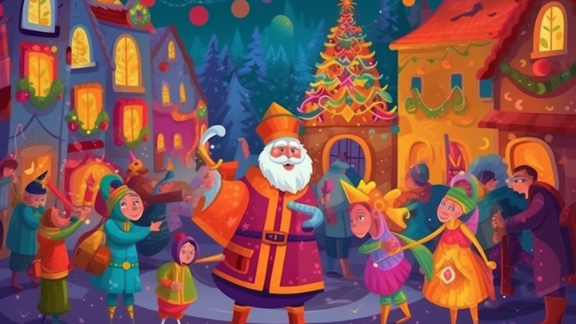
European Traditions: From Markets to Krampus
The Christmas season in Europe is rich in traditions and vibrant celebrations, deeply rooted in the continent’s diverse cultural and geographic landscapes. From the bustling Christmas markets of Germany and France to the ancient Alpine traditions of Austria, each region adds its unique flavor to the festive season.
The Charm of Christmas Markets in Germany and France
In Germany, the Christmas market, or ‘Weihnachtsmarkt’, is a quintessential feature of the holiday season. These markets, which date back to the Middle Ages, transform city centers into winter wonderlands, filled with rows of quaint stalls selling handcrafted gifts, decorations, and traditional treats. The geography of Germany, with its historic towns and cold winters, provides the perfect backdrop for these festive gatherings. The most famous markets, like those in Nuremberg and Dresden, draw visitors from all over the world, eager to experience the magical atmosphere and sample seasonal specialties like Glühwein (mulled wine) and Lebkuchen (gingerbread).
In France, the Christmas markets have a distinct Gallic charm. The Alsace region, with its unique blend of French and German influences, hosts some of the country’s most renowned markets. Strasbourg, known as the “Capital of Christmas,” boasts a market that dates back to 1570, making it one of the oldest in Europe. These markets are a celebration of local culture and geography, showcasing regional crafts and delicacies like pain d’épices (spiced bread) and vin chaud (hot wine).
Alpine Traditions: The Legend of Krampus in Austria
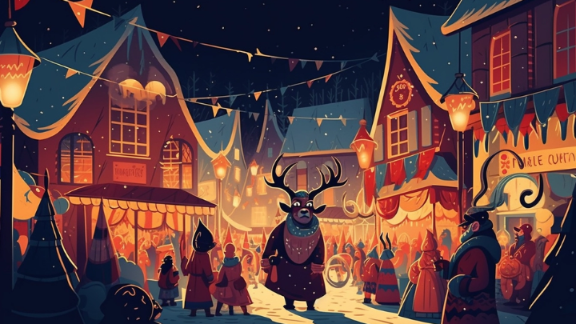
Moving to the Alpine region of Austria, the Christmas season brings with it a tradition that is both fascinating and somewhat intimidating. The legend of Krampus, a horned, demonic creature from folklore, is a stark contrast to the jolly figure of Saint Nicholas. Krampus is said to roam the streets on Krampusnacht, the eve of Saint Nicholas Day, punishing misbehaving children. This tradition, deeply rooted in Alpine mythology, reflects the harsher aspects of the region’s geography and climate, where the dark, cold winters have given rise to a more ominous side of Christmas folklore.
The Krampus parades, especially popular in rural areas, feature locals dressed in elaborate costumes and masks, often made from wood and sheepskin, embodying the menacing figure of Krampus. These parades are not just a display of cultural heritage, but also a testament to the deep connection between the Alpine people and their environment. The rugged mountains and dense forests of the region have long been a source of myth and legend, with Krampus serving as a reminder of the darker, more mysterious aspects of these landscapes.
The Christmas traditions of Europe, from the festive markets of Germany and France to the ancient legend of Krampus in Austria, are a vivid reflection of the continent’s diverse geography and cultural heritage. These traditions, whether they bring cheer or chills, are an integral part of the European winter season, each telling a story of the people and the landscapes from which they emerged.

Christmas Down Under: Australia and New Zealand
In the Southern Hemisphere, the festive season falls in the heart of summer, offering a Christmas experience that stands in stark contrast to the wintry traditions of the Northern Hemisphere. Australia and New Zealand, with their warm December weather and unique landscapes, have developed their own distinct ways of celebrating Christmas, deeply influenced by their geography.
Summer Celebrations in Australia
In Australia, the traditional imagery of snow and sleigh bells gives way to sun-soaked beaches and outdoor barbecues. The geographical location of Australia, sprawling across diverse landscapes from coastal areas to arid outback, allows for a variety of Christmas celebrations. One of the most iconic images of an Australian Christmas is that of ‘Surfing Santas’. Beaches like Bondi in Sydney become festive gathering spots, where people dress up in Santa hats and swimsuits, embracing the holiday spirit under the Australian sun.
Christmas meals in Australia often feature seafood and barbecued meats, a reflection of the country’s abundant coastal resources and the warm weather that encourages outdoor cooking. Families gather in backyards or head to public parks for picnics and barbecues, taking advantage of the long summer days. This outdoor culture, deeply ingrained in the Australian way of life, naturally extends to their Christmas celebrations.
A Kiwi Christmas: Traditions in New Zealand
New Zealand, with its picturesque landscapes ranging from pristine beaches to verdant hills, also celebrates Christmas in the warmth of summer. The country’s Maori heritage and British colonial history blend to create a unique Christmas culture. Traditional British Christmas fare like ham and roast turkey is often accompanied by local specialties such as pavlova, a meringue-based dessert named after the Russian ballerina Anna Pavlova, which has become a Christmas staple.
Outdoor activities play a significant role in New Zealand’s Christmas celebrations. Families often spend the day at the beach, indulging in swimming, cricket, or simply relaxing under the pohutukawa tree, famously known as New Zealand’s Christmas tree for its bright red flowers that bloom in December. The geography of New Zealand, with its mild climate and stunning natural beauty, invites residents to enjoy the outdoors during the festive season.
In both Australia and New Zealand, the geography and climate of the Southern Hemisphere play a pivotal role in shaping Christmas traditions. The warm summer weather and diverse landscapes offer a refreshing take on the festive season, where outdoor festivities, beach gatherings, and unique local customs come together to create a joyous celebration of Christmas Down Under.
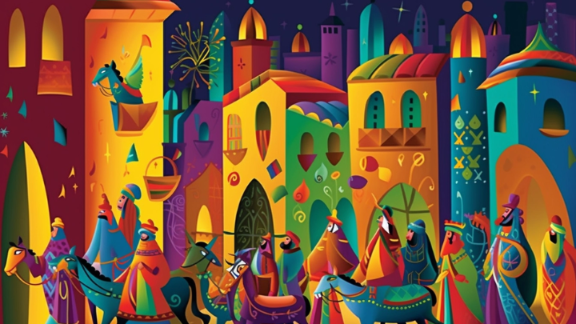
The Spiritual Heart: Bethlehem and the Middle East
In the Middle East, the Christmas season resonates with deep historical and spiritual significance, especially in Bethlehem, a city that lies at the heart of the Christmas narrative. This region, with its ancient landscapes and rich religious heritage, offers a Christmas experience that is profoundly different from the commercialized celebrations in much of the world.
Bethlehem: The Birthplace of Christmas
Bethlehem, located in the West Bank, holds a place of paramount importance in Christian tradition as the birthplace of Jesus Christ. The geographical and historical significance of this ancient city is unparalleled in the context of Christmas. The Church of the Nativity, a UNESCO World Heritage site believed to be located on the spot where Jesus was born, attracts pilgrims from around the world. Here, Christmas is not just a seasonal celebration but a year-round testament to the city’s spiritual heritage.
The Manger Square, adjacent to the Church of the Nativity, becomes a focal point of celebrations during Christmas. The mix of cultural and religious practices in Bethlehem and the surrounding areas is a direct reflection of the diverse and complex history of the Middle East. The geographical location of Bethlehem, at the crossroads of different civilizations, has imbued the city with a rich tapestry of cultural and religious traditions that are prominently displayed during the Christmas season.
Christmas Celebrations in the Middle East
Beyond Bethlehem, the celebration of Christmas in the Middle East varies significantly, influenced by the region’s diverse religious and cultural landscape. In predominantly Christian communities in countries like Lebanon and Syria, Christmas is celebrated with great fervor. Midnight Mass, nativity plays, and festive feasts mark the occasion, blending local traditions with the religious significance of the holiday.
In Lebanon, for example, Christmas celebrations include the decoration of homes with lights and nativity scenes, and the preparation of special foods like kibbeh and tabbouleh. The display of both the Christmas tree and the nativity scene in homes reflects the harmonious blend of Western and Eastern Christian traditions.
In places where Christians are a minority, such as in parts of the Arabian Peninsula, Christmas is celebrated more quietly and privately. However, the spirit of the season is still felt, often marked by community gatherings and religious services within the confines of churches or private homes.
The celebration of Christmas in Bethlehem and across the Middle East is a profound reminder of the holiday’s ancient origins. The geographical and historical significance of the region, particularly Bethlehem, offers a unique perspective on Christmas, highlighting its spiritual and religious roots. Amidst the region’s diverse cultural and religious landscape, the Christmas season stands as a beacon of hope and a time for reflection on the shared values of peace and goodwill.

Tropical Christmas: The Caribbean and Southeast Asia
In the warm and vibrant regions of the Caribbean and Southeast Asia, Christmas is celebrated under the tropical sun, offering a colorful and diverse contrast to the traditional winter holiday image. The geography of these regions, characterized by lush landscapes, warm seas, and a rich cultural heritage, shapes unique Christmas traditions that are as diverse as they are lively.
A Caribbean Christmas Celebration
In the Caribbean, Christmas is a fusion of various cultures, including African, European, and native influences, resulting in a celebration that is both lively and deeply rooted in local traditions. The tropical climate means that instead of snow and cold weather, Christmas is celebrated in a warm, festive atmosphere.
In countries like Jamaica, Trinidad and Tobago, and Barbados, the season is marked by vibrant parades, lively music, and community gatherings. Calypso and reggae Christmas carols are a unique feature of the holiday, reflecting the region’s musical heritage. Homes and streets are decorated with colorful lights and tropical flowers, and community festivals are common, bringing people together in a spirit of celebration.
Food plays a significant role in the Caribbean Christmas, with traditional dishes such as Jamaica’s Christmas cake, a rich, rum-infused fruitcake, and Trinidad’s pastelles, a cornmeal and meat (or fish) delicacy, steamed in banana leaves. These culinary traditions not only highlight the region’s diverse flavors but also its history and cultural influences.
Christmas in Southeast Asia
In Southeast Asia, where Christianity coexists with a variety of other religions, Christmas is celebrated with a unique blend of local traditions and Western influences. In predominantly Christian countries like the Philippines, Christmas is one of the biggest holidays of the year, celebrated with a fervor that rivals any other nation.
The Philippines is known for its “Simbang Gabi,” a series of nine dawn masses leading up to Christmas Day, reflecting the country’s strong Catholic heritage. Houses and streets are adorned with elaborate lanterns called “parols,” symbolizing the Star of Bethlehem. The festive spirit is palpable, with caroling, festive markets, and large family gatherings dominating the season.
In other parts of Southeast Asia, such as Thailand and Indonesia, where Christians are a minority, Christmas is still observed, often focusing more on commercial and secular aspects. Hotels, shopping malls, and major cities in these countries often showcase elaborate Christmas decorations and host various holiday-themed events, catering both to the local Christian population and international tourists.
Christmas on Christmas Island
Christmas Island, an Australian territory in the Indian Ocean, offers a unique take on the holiday. Named for its discovery on Christmas Day in 1643, the island has a small population that celebrates Christmas with a blend of traditions influenced by its diverse ethnic makeup, including Chinese, Malay, and European cultures. The island’s natural beauty, with its lush rainforests and unique wildlife, adds a distinctive backdrop to the celebrations.
In the Caribbean and Southeast Asia, as well as on Christmas Island, the warm tropical climate and rich cultural landscape give rise to unique Christmas traditions. These celebrations, infused with local customs, foods, and music, offer a vibrant and colorful perspective on the holiday, showcasing the diverse ways in which Christmas is celebrated around the world.

The Americas: From Sinterklaas to Feliz Navidad
In the vast and diverse expanse of the Americas, Christmas traditions are as varied as the geography itself, ranging from the snowy landscapes of the north to the tropical climates of the south. The region’s rich history of immigration and cultural exchange has led to a unique blend of Christmas customs, deeply influenced by its diverse peoples.
The Dutch Influence on North American Christmas
The transformation of the Dutch ‘Sinterklaas’ into the iconic American ‘Santa Claus’ is a fascinating example of how immigration has shaped Christmas traditions in North America. When Dutch settlers arrived in the New World, they brought with them the tradition of Sinterklaas, a kind and elderly bishop who delivered gifts to children on the eve of Saint Nicholas Day (December 5th). This tradition gradually merged with British and other European Christmas customs to create the figure of Santa Claus, now synonymous with Christmas in the United States and Canada.
The American Santa Claus, with his red suit, jolly demeanor, and reindeer-led sleigh, became a central figure in Christmas celebrations, embodying the spirit of generosity and cheer. The evolution of Sinterklaas into Santa Claus is a prime example of how geographic relocation and cultural assimilation can lead to the creation of new traditions deeply ingrained in the cultural fabric of a nation.
Latin American Celebrations: Las Posadas and Beyond
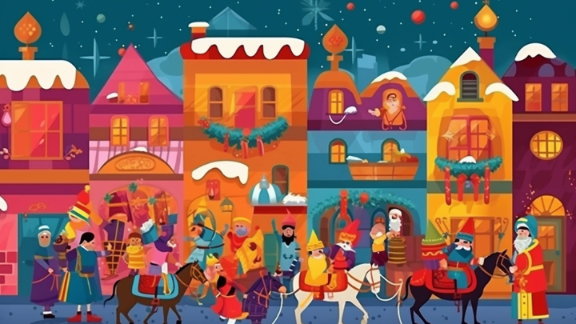
In Latin America, Christmas is a blend of indigenous, Spanish, and other European influences, resulting in a variety of rich and colorful traditions. One of the most notable is ‘Las Posadas’, a tradition primarily observed in Mexico and parts of Central America. Las Posadas, which means “the inns” in Spanish, is a nine-day celebration leading up to Christmas, reenacting Joseph and Mary’s search for lodging in Bethlehem.
Each evening during Las Posadas, participants gather to form a procession, symbolically seeking shelter. Houses are designated as ‘inns’, and at each stop, songs are sung, and the story of the Nativity is told. The procession is often accompanied by the breaking of piñatas and festive meals, creating a vibrant community atmosphere.
In other parts of Latin America, unique traditions reflect the region’s diverse geography and cultural heritage. In Brazil, for example, ‘Papai Noel’ (Father Christmas) is believed to bring gifts to children, and in Venezuela, it’s customary to attend early morning Mass during Christmas, with streets often closed to cars so that people can roller-skate to church.
The Christmas traditions of the Americas, from the Dutch-influenced Santa Claus in North America to the colorful and spiritual celebrations like Las Posadas in Latin America, are a vivid illustration of the continent’s cultural diversity and historical richness. These traditions, whether they involve gift-giving figures like Santa Claus or community-centric events like Las Posadas, reflect the varied influences and geographical nuances of the Americas, creating a festive tapestry that is both diverse and deeply meaningful.
Wrap Up...
As our journey through the landscapes of Christmas traditions around the world comes to a close, it becomes strikingly clear how deeply geography shapes and colors these celebrations. From the snow-draped markets of Germany to the sun-kissed beaches of Australia, from the historical streets of Bethlehem to the vibrant communities of the Caribbean, each region adds its unique brushstroke to the global portrait of Christmas.
The geographical diversity we have explored reveals not only the adaptability of Christmas traditions but also their deep-rooted connections to the lands and cultures from which they spring. In Scandinavia, the long, dark winters give rise to a Christmas filled with light and warmth, a stark contrast to the sunny, outdoor festivities of the Southern Hemisphere. Meanwhile, in the Middle East, the historical and spiritual significance of locations like Bethlehem infuses Christmas with a profound sense of heritage and reverence.
Yet, amidst this incredible variety, there are universal themes that resonate across all borders and cultures. The joy of the season, irrespective of the climate or geography, is a constant. Whether it’s through the exchange of gifts, the gathering of families, or the participation in communal festivities, the spirit of joy and giving transcends geographical boundaries, uniting people around the world in a shared celebration.
Equally universal is the theme of community. Christmas, in its many forms and expressions, has the power to bring people together, fostering a sense of belonging and togetherness. This is evident in traditions like Las Posadas in Latin America, where communities come together to reenact Mary and Joseph’s journey, and in the communal feasts and gatherings that mark the season in various cultures.
In conclusion, the geography of Christmas is as diverse as the planet itself yet bound by the common threads of joy and community. These celebrations, shaped by the lands and peoples they originate from, not only add richness to our understanding of the world but also remind us of the shared human experience that connects us all. As we reflect on the myriad ways in which Christmas is celebrated, we are reminded of the beauty and diversity of our world, and the universal values that the festive season embodies.

